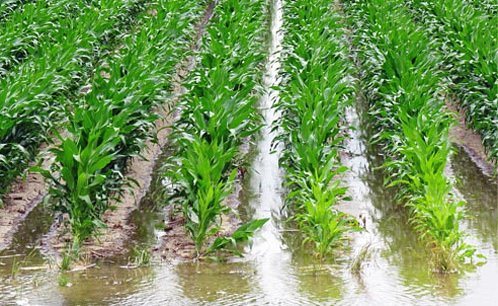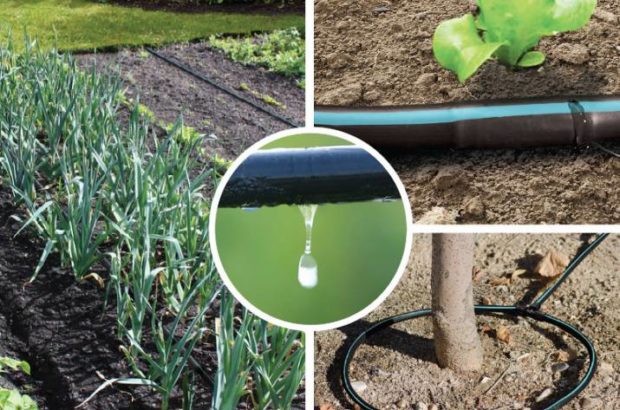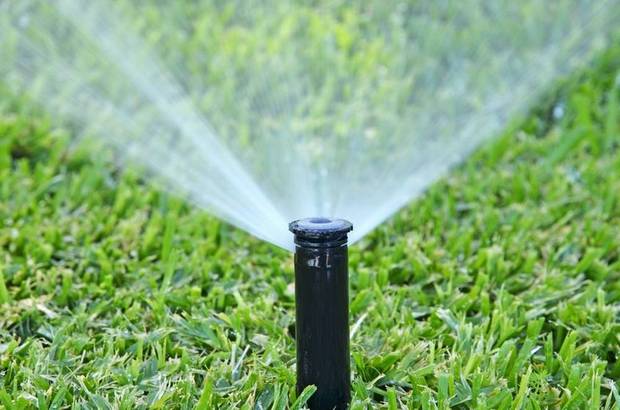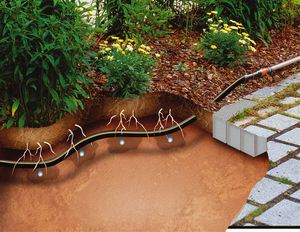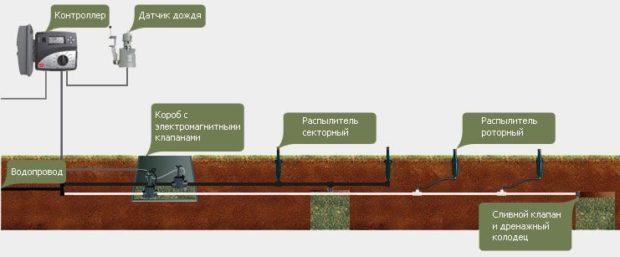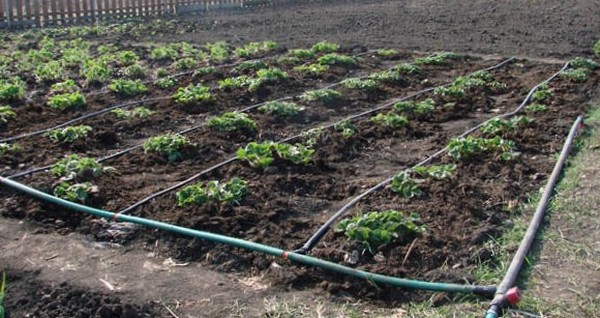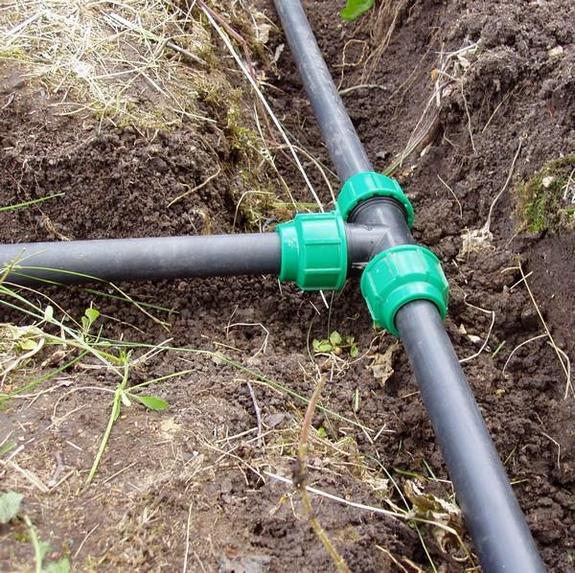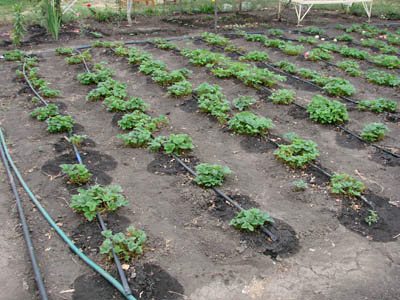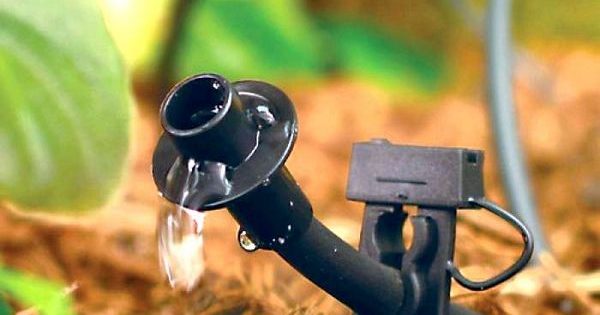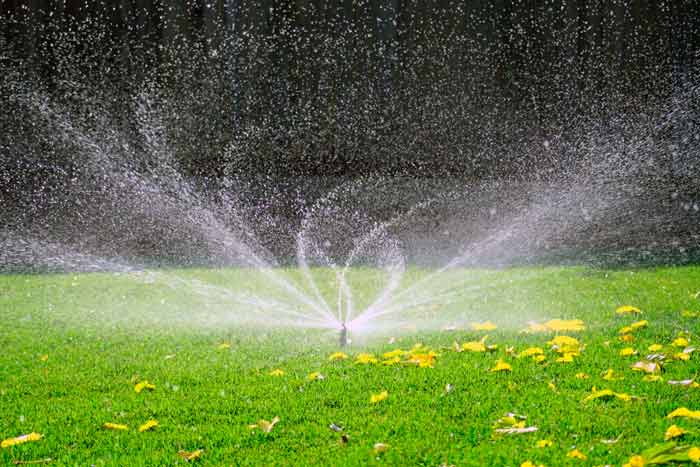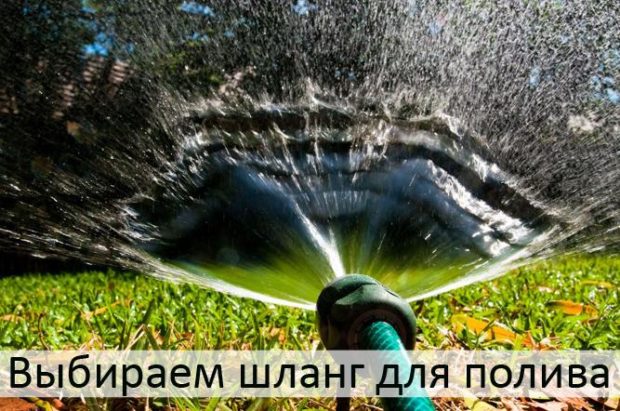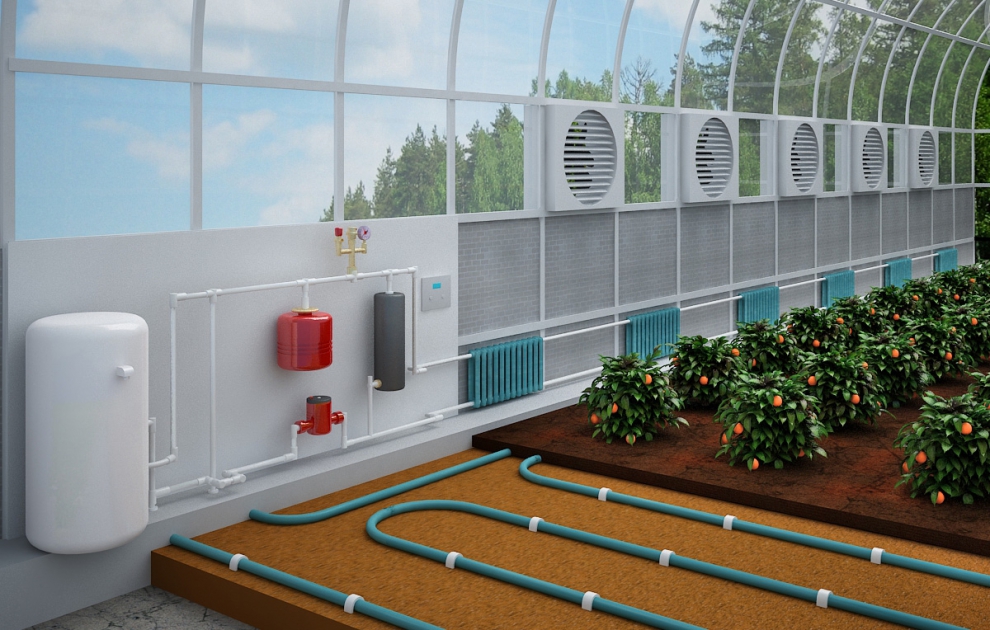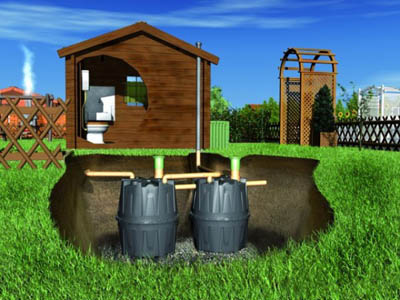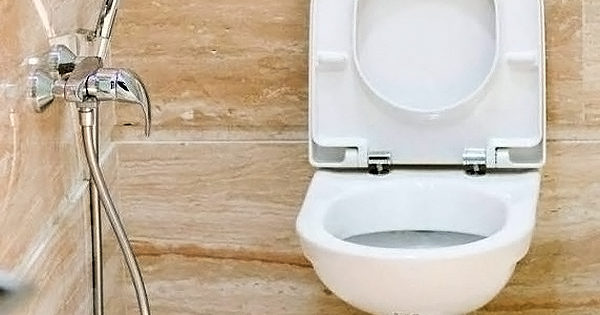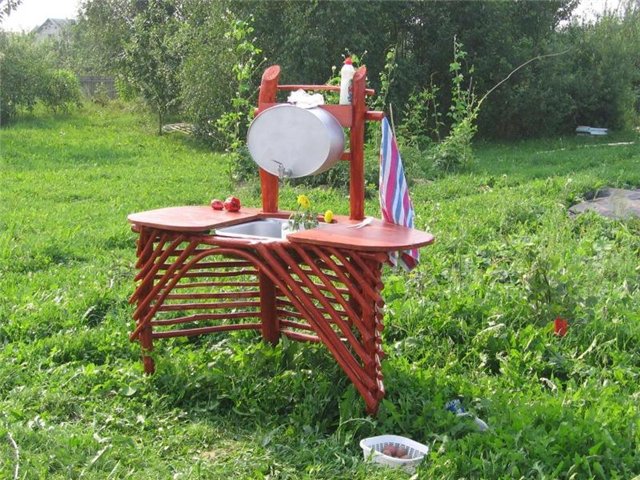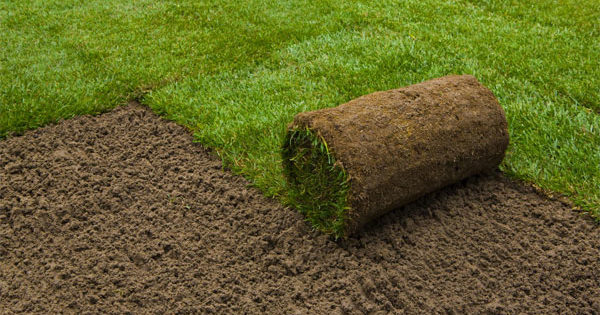8 tips for organizing a watering system in the country
The key to the annual good harvest and soil fertility at your summer cottage is timely feeding and fertilizing the land and, of course, constant watering. Proper and competent arrangement of the irrigation system will allow not only to ensure timely and regular moistening of the soil, even in your absence, but also save a lot of money. In this article we will give some useful advice on organizing irrigation systems in the country, consider their main types and highlight the advantages and disadvantages of each system.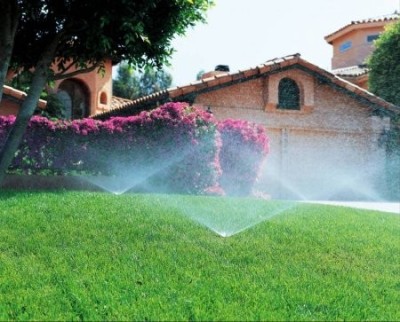
1. Surface or gravity irrigation system
Simplest system irrigation, for the organization of which neither specific knowledge nor the costs associated with the procurement of material are required. The process of arranging such a system boils down to the fact that a narrow trench is excavated on both sides of each bed, with a depth of 10-15 cm. Next, you can either make a supply plastic pipe to each trench, or to lay watering hose. You can connect the hose to a regular water barrel, which is installed at a height of 1.5-2 meters above the ground. This will ensure that water flows out of the hose under its own pressure. You can use a centralized water supply. In this case, a large pressure is not required - the main thing is that there is enough pressure to exit the water from the hose. This is true when the beds are located at a decent distance from the water tap.
In addition to the furrow method, the surface irrigation system can be carried out in an estuary way. In this case, trenches are not required, because the entire surface of the beds is completely filled with water so that for some time it stands on the surface. If you really will use this method, then it is worth assessing the state of the landscape. On inclined or bumpy areas, uniform watering will be problematic. By what the benefits This watering system has:
- Easy to organize and maintain
- Requires minimal human involvement;
- It takes less effort and energy than regular watering with a watering can.

On this positive points end. Regarding disadvantages:
- Such a method of irrigation is not suitable for all garden crops;
- When the soil is poured with large amounts of water, the amount of oxygen that enters the roots of the plants decreases significantly;
- A hard crust quickly forms on the surface of the earth, as a result of which the soil becomes heavier and loses its ability to absorb;
- Uneconomical water consumption.
Experienced summer residents have long ceased to use similar methods of watering and strive to organize more thoughtful systems. These include the following types. However, if you are quite comfortable with surface irrigation and, most importantly, it is suitable for crops growing on your site in terms of frequency of irrigation and the amount of liquid supplied, you should not refuse it. The irrigation system should meet your personal needs, and not the advent of more modern technologies, chasing which sometimes does not make sense.
2. Drip irrigation system
This method is the most gentle and economical. It is advisable to use for radical watering of plants that are particularly sensitive to drought. Organizing a drip irrigation system is quite simple. It includes several basic elements:
- Capacity with water;
- Stopcock;
- Filter;
- Start connector;
- Drip watering hose;
- End cap for the number of hoses used.

Such irrigation can be carried out both from the storage tank, and using the main pipeline. It is necessary to equip the central pipe, which will have the number of connectors equal to the number of beds. Length drip hose should correspond to the length of the beds and have a small margin. It should be located as close as possible to the seedlings. Watering can be continuous: the main thing is that the capacity of the water tank is appropriate.
In case of using water from the pipeline, it is possible to equip the system with a timer, which, according to the established mode, will open and close the water supply. When organizing a drip irrigation system, be sure to install a filter before entering the water directly into the drip hose. Process water has many impurities and small debris that quickly clogs holes. Drop watering has a mass advantages:
- Due to the fact that water immediately gets to the roots, its consumption is minimal, and at the same time its hydration is more than sufficient;
- Uniform water supply to plants;
- The system is practically insensitive to pressure drops;
- For the same reason, plants do not have to be watered early in the morning or in the evening. The stems and foliage remain dry, and the plants are not burnt under the scorching sun;
- Full oxygen access to the roots is maintained;
- A hard crust does not form on the surface of the earth.
- It is possible to make the irrigation process automated.
TO disadvantages only frequent clogging of small holes on the bottom of the drip hose can be attributed. In addition to the fact that plaque will settle in the holes, the lower rows will become clogged with particles of moist soil. In this regard, many experienced gardeners recommend laying the hose at a low height above the soil. Then this problem can be avoided.
3. Sprinkler system
Another no less effective method site wetting - the use of so-called sprinklers. They can have a different angle of irrigation and be rotary or static. This makes it possible to water the entire site without leaving dry islands. It makes no sense to use a similar method on small areas. The radius of action of water spray reaches about 2 meters. Such an irrigation method will also be ineffective with insufficient pressure in the system. In this regard, the system is additionally equipped with a pump. It works in automatic mode and turns on only when necessary, when the pressure is insufficient. Thus, it is possible to compensate for the shortcomings and maintain a constant pressure at the required level.
Static Sprinklers may have an irrigation angle of 90 °, 180 ° or 270 °. Respectively rotary cover an angle of 360 °. By combining systems with different angles, it is easy to ensure uniform watering even in the most remote places or, conversely, to limit the territory. A similar system is suitable for moisturizing lawns and flower beds with ornamental shrubs and trees.
If you plan to irrigate a plot with vegetables in this way, you should consider a timer that will turn on the water in the early morning or evening so that the sun does not burn the young shoots. Regions with lawn grass periodically have to mow. So that the irrigation system does not interfere with this process, give preference to varieties of sprinklers, which, when unnecessary, hide in a special cavity in the ground and become almost invisible. To explicit the benefits this system can include:
- Watering with scattered water does not harm the soil structure and does not wash the root system of plants;
- The soil is moistened deeply and efficiently;
- Humidity increases;
- There is no movement of water on the surface, that is, the fertile layer is not washed away;
- Dust is washed off the leaves, which normalizes their metabolism;
- The aboveground part of plants, such as trunks and leaves, is also saturated with moisture, which in turn increases their productivity;
- Long range of action of water splashes.

disadvantages manifest as follows:
- If the irrigation system is not turned off in time, puddles with stagnant water are locally formed on the site, and too moist soil will cease to absorb water at all. Recommended watering time - no more than 30 minutes. This is quite enough for a deep, high-quality irrigation;
- If the above is not observed, a hard crust forms on the soil, which prevents the access of oxygen to the roots;
- With a strong wind, water spray will drift in different directions, which will make uniform watering impossible;
- Incorrect radius of action will also be with weak water pressure in the line.
- High cost of the system.
4. Intrasoil irrigation
The subsoil irrigation system is a system plastic pipesthat are divorced throughout the site underground. The minimum laying depth is 30 cm. At a certain distance, small holes are made in the pipes, which provide water access to the rhizomes of plants. Typically, such a system is used in areas that are not susceptible to digging. The optimal material for organizing the subsoil irrigation system are polyethylene pipes. They possess a number of the benefits before other types of plastic pipes, namely:
- Ease of installation;
- High strength and durability;
- The ideally smooth surface of the inner walls excludes the possibility of the formation of various deposits on them, which is very important in hidden systems;
- The soil is an aggressive environment, to the influence of which plastic is completely inert, unlike metal;
- Polyethylene pipes are not destroyed even when the water inside them freezes;

When laying pipes to the bottom of the trench poured river sand layer, then fine crushed stone, then the pipe is laid and the trench is backfilled. Sand and gravel pillow provides removal of excess moisture. To lay the pipes around the site and their connection between themselves will not cause difficulties. It is important only to correctly calculate the required amount of material. This process is quite time-consuming, but it has many advantages:
- Intrasoil irrigation is very economical, as the water goes directly to the roots.
- It also has a minimum evaporation rate;
- The formation of a harmful crust on the soil is completely excluded and free access of oxygen to the roots is ensured;
- In this regard, there is no need to constantly push the top layer.
TO disadvantages include:
- The lack of irrigation of the subsoil parts of plants, which is designed to increase their fertility;
- Not used on sandy soils;
- The complexity of the process and the costs associated with the acquisition of material.
5. How to choose the most suitable irrigation system
The answer to this question is quite simple to find, analyzing the features your landscape the plot and the types of plants that grow on it. It often happens that trees grow on one plot along the perimeter, one part is designated for rest and planted with lawn grass, and the second is a small garden. Many grow grapes in the country. It is clear that watering plants that are so different both in height and in terms of water consumption by the same method is inappropriate. Some will be buried in excess water, while others will not receive even half the necessary moisture. In this regard, the irrigation system often consists of several lines. For example, sprinklers can be used to water grass and trees, and a drip system is ideal for moistening vines and vegetable crops.It is possible to organize subsurface irrigation throughout the entire area of a small garden. To understand how organize correctly irrigation system yourself, you must:
- Draw a plan of the site on which the water supply tap, storage tank (if any) and areas where trees, grass, shrubs, grapes and other plants grow should be marked.
- Mark the location of sprinklers on the plan, noting the radius of their action, mark the line of drip and other types of irrigation. At this stage, it is important to place everything so that the site is watered completely. In the corners, it is convenient to install sprinklers with an irrigation angle of 90 °. Between them - with an angle of action of 180 °. Thus, you will build an irrigation wall around the perimeter of the entire plot. In the middle of the lawn you can set rotary sprinkler.
- Decide on the water supply. For owners of large areas, it is advisable to think about their own well or a well in which a suitable pump is located. You can take water from a pipeline, water tank, or natural source — a river or lake.

- Mark on the plan of the place of connection of pipes, this will help to calculate the number of connectors and splitters.
- Make a list of all the necessary materials.
- Form all beds before laying the system.
- When starting for the first time, be sure to flush the system and check its strength. To do this, remove all plugs and set the water supply to maximum. This will help immediately identify a leak.
- Calculate the water intake of each element and determine the total amount. For example, rainwaters may have a consumption of 12, 14, 7, 9, or 6, depending on the angle of action and the area of irrigation. If the crane capacity is less than the final figure, it is necessary to divide the system into several lines.
6. Types of irrigation system control
Management of the irrigation system in the country can be either manual or more advanced. Consider three main types:
- Manual - The easiest way. In this case, each watering line is equipped with a shut-off valve, which opens and closes manually each time it is necessary. That is, a constant human presence is necessary. It often happens that the opportunity to visit a summer cottage appears only on weekends, that is, on weekdays all plants are left without moisture. This method does not always satisfy the need of the plants themselves, which may simply die from drought. In addition, ball valves with constant on / off wear out very quickly and can fail at the most inopportune moment. Always keep a couple of taps in reserve in case of an unplanned replacement.
- Auto the control method performs irrigation without human intervention for a given program. The system is equipped with a timer that allows you to turn on the water supply in a certain period of time every day or every other day, as you need. All elements of the system are connected together inside a special controller. It can work both on batteries and on mains. For the safety of the device, we recommend placing it in the basement or in utility room. The system can be assembled on your own or you can buy a finished one. In such a simple way, you will protect the plants from drought, but you will not be able to prevent overflow. For example, if it rains at a given time for watering, watering will happen anyway. If for your plants this situation has a detrimental effect, then it is better to think about an automated control method.

- Automated - A computer view of the control of the irrigation system, which depends on the readings of the sensors. They should be located throughout the site. These can be sensors for soil moisture, temperature, environmental humidity and rainfall sensors. If it started to rain, the system will turn off the water supply and turn it back on when the rain ends, if the soil is not sufficiently moistened. The disadvantage of such a system is its high cost.
7. Types of installation of irrigation system
We mentioned that polyethylene pipes are used to organize an irrigation system in the country. The diameter of the main line should have more. For example, a pipe with an inner diameter of 40 mm is most often used, and 20 mm is sufficient for branch pipes. Connections are made using compression fittings, which eliminates the need to purchase or use a special tool. Only required the availability of electricity for the work of a soldering iron. Correctly position the pipes There are two ways to irrigate:
- Surface installation - the entire pipeline will be located above or on the ground. The advantage of this installation is the ease of assembly, identification and elimination of leaks and other problems. The disadvantages include the possibility of an accidental damage to the integrity of the pipe, more difficult and limited movement in the area, and the easy availability of materials for attackers. If you are rarely in the country, then it is highly likely that your system will be absent at the next visit.

- Deep installation is a more reliable, therefore, preferred installation method. For its implementation, trenches 30-70 cm deep are dug in the right place. In this case, a slight slope towards the lowest point of the site should be provided. This is necessary for unimpeded drainage of water from the system at the end of the irrigation season. After this, the side lines are inserted into the main pipe. Experts recommend equipping each branch with a valve. This is necessary for more precise control of the humidity level in a particular area. Sprinklers or droppers are attached to the end of the branch pipes. After that, the system is checked and its strength test by supplying water. When you are convinced that there are no leaks and at each point of irrigation you have the same pressure, the trenches are buried. Such a system will last for many years and provide high-quality watering.

8. How to water the plants
In addition to the correct selection of the type of irrigation and its competent organization, it is necessary to observe elementary rules that will make it possible to moisturize most useful:
- The main rule is that any watering should be systematic. In other words, it should not depend on either the month or the hours of watering. Ideally, there should always be a spare water tank.
- It is better to water less often, but plentifully. During a period of high heat, insignificant, but frequent watering not only does not bring benefits, but can also harm plants. Moisture still does not reach the main roots, but a hard crust forms quickly on the soil, which not only restricts oxygen access, but also increases the evaporation of water.
- Most of the roots are located at a depth of 20-25 cm in fertile crops and at a depth of about 15 cm in lawn grass. To completely wet the soil with a depth of 25 cm, about 25 liters of water per 1 m2 are required. Lawns can be periodically refreshed during a period of drought.
- An important role is played by the temperature of the water for irrigation. If you take water directly from a well or from a well, it will have a temperature of about 10-12 ° C. For plants, this will be a shock, which will lead to their weakening. Ideally, the temperature of the water should be the same or slightly higher than the temperature of the soil. It is clear that no one will specifically heat water for irrigation, but it is desirable to acquire an accumulation tank. Its volume can be both 200 and 5000 liters, depending on the area of the site. Being in a tank under the sun, the water warms up to an acceptable temperature.

- To ensure sufficient pressure in the automatic irrigation system, it should be placed at a height of 2-3 meters above the ground and above. A difference in height of 1 meter can create a pressure of 0.1 bar. For the normal functioning of many systems, the minimum pressure should be at least 2-3 bar. In this regard, special pumps are often installed.
- It is a mistake to assume that if it has rained today, then the site does not need watering.Sometimes even heavy rainfall is not able to properly moisten the soil to the desired depth. You can reduce the duration of irrigation by first evaluating the condition of the soil, but not cancel it altogether.
- The norms of water consumption by vegetable crops reach their maximum values during the period of intensive growth - from late spring to mid summer. It is during this period that the rate of development of a plant is determined by the amount of water it consumes. The average rate is 10-15 l / m2 per week.
- Watering should be either morning or evening, when the sun does not have such a negative effect on young plants.
- Before choosing this or that type of watering, be sure to study the needs of the plants you grow. Perhaps they are contraindicated in getting water on the leaves.

